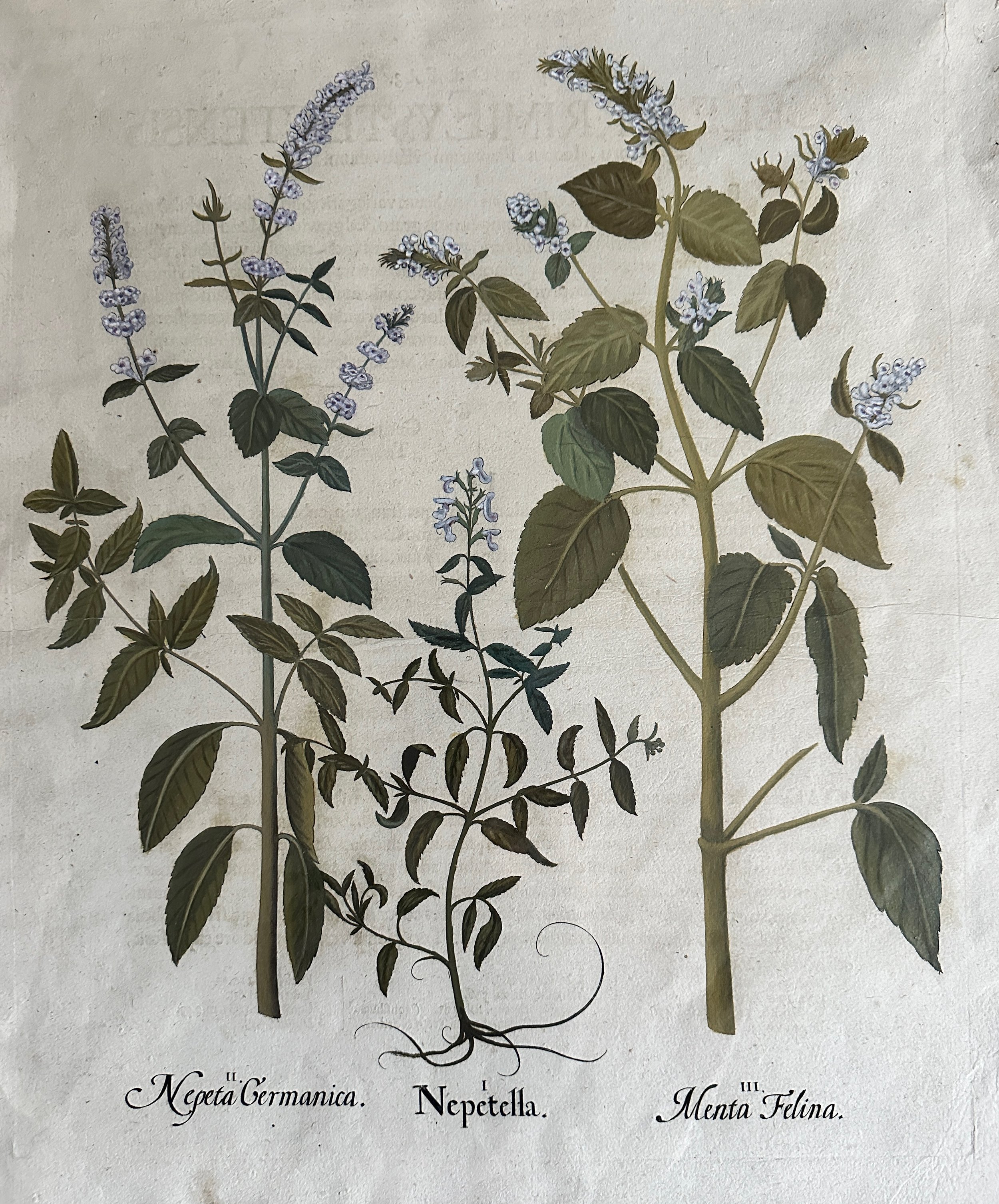Nepetella, by Basil Besler
This original hand-colored copperplate engraving, Nepetella, Pl. 229, measures 20" x 16.5" and is in very good condition with light staining and evidence of verso page text. Illustrated on this engraving are plants commonly known as Smooth Catmint, Small catmint and Catnip. This engraving is expertly hand-colored with the stems and leaves in rich shades of green and the delicate flowers in white and lavender. Catnip and catmint are members of the genus Nepeta which is commonly used as a stimulant for cats' pheromonic receptors, typically resulting in temporary euphoria.
Basil Besler’s (1561-1629) great botanical work, “Hortus Eystettensis” is a landmark of botanical documentation and pre-Linnaean classification, as well as one of the most splendidly stylized and aesthetically powerful botanical works ever produced. Besler was an apothecary and botanist who managed the gardens of Bishop Johann Conrad in Eichstatt, Germany. The Bishop’s remarkable garden was one of the most extensive in Europe, containing a huge variety of European shrubs and flowering plants, as well as exotic specimens from Asia and the Americas. Besler used this encyclopedic resource as the basis for the “Hortus Eystettensis”, in which he studied and depicted over a thousand flowers, representing 667 species in all. With the Bishop’s patronage, he worked both as artist and publisher, directing a team of ten artists and engravers in creating 367 plates over 16 years. Published one hundred and fifty years before Linnaeus created his thorough system of classification; Besler’s great florilegium represents an impressive early attempt to classify plants for the benefit of botanists, doctors and apothecaries.
This original hand-colored copperplate engraving, Nepetella, Pl. 229, measures 20" x 16.5" and is in very good condition with light staining and evidence of verso page text. Illustrated on this engraving are plants commonly known as Smooth Catmint, Small catmint and Catnip. This engraving is expertly hand-colored with the stems and leaves in rich shades of green and the delicate flowers in white and lavender. Catnip and catmint are members of the genus Nepeta which is commonly used as a stimulant for cats' pheromonic receptors, typically resulting in temporary euphoria.
Basil Besler’s (1561-1629) great botanical work, “Hortus Eystettensis” is a landmark of botanical documentation and pre-Linnaean classification, as well as one of the most splendidly stylized and aesthetically powerful botanical works ever produced. Besler was an apothecary and botanist who managed the gardens of Bishop Johann Conrad in Eichstatt, Germany. The Bishop’s remarkable garden was one of the most extensive in Europe, containing a huge variety of European shrubs and flowering plants, as well as exotic specimens from Asia and the Americas. Besler used this encyclopedic resource as the basis for the “Hortus Eystettensis”, in which he studied and depicted over a thousand flowers, representing 667 species in all. With the Bishop’s patronage, he worked both as artist and publisher, directing a team of ten artists and engravers in creating 367 plates over 16 years. Published one hundred and fifty years before Linnaeus created his thorough system of classification; Besler’s great florilegium represents an impressive early attempt to classify plants for the benefit of botanists, doctors and apothecaries.
This original hand-colored copperplate engraving, Nepetella, Pl. 229, measures 20" x 16.5" and is in very good condition with light staining and evidence of verso page text. Illustrated on this engraving are plants commonly known as Smooth Catmint, Small catmint and Catnip. This engraving is expertly hand-colored with the stems and leaves in rich shades of green and the delicate flowers in white and lavender. Catnip and catmint are members of the genus Nepeta which is commonly used as a stimulant for cats' pheromonic receptors, typically resulting in temporary euphoria.
Basil Besler’s (1561-1629) great botanical work, “Hortus Eystettensis” is a landmark of botanical documentation and pre-Linnaean classification, as well as one of the most splendidly stylized and aesthetically powerful botanical works ever produced. Besler was an apothecary and botanist who managed the gardens of Bishop Johann Conrad in Eichstatt, Germany. The Bishop’s remarkable garden was one of the most extensive in Europe, containing a huge variety of European shrubs and flowering plants, as well as exotic specimens from Asia and the Americas. Besler used this encyclopedic resource as the basis for the “Hortus Eystettensis”, in which he studied and depicted over a thousand flowers, representing 667 species in all. With the Bishop’s patronage, he worked both as artist and publisher, directing a team of ten artists and engravers in creating 367 plates over 16 years. Published one hundred and fifty years before Linnaeus created his thorough system of classification; Besler’s great florilegium represents an impressive early attempt to classify plants for the benefit of botanists, doctors and apothecaries.

